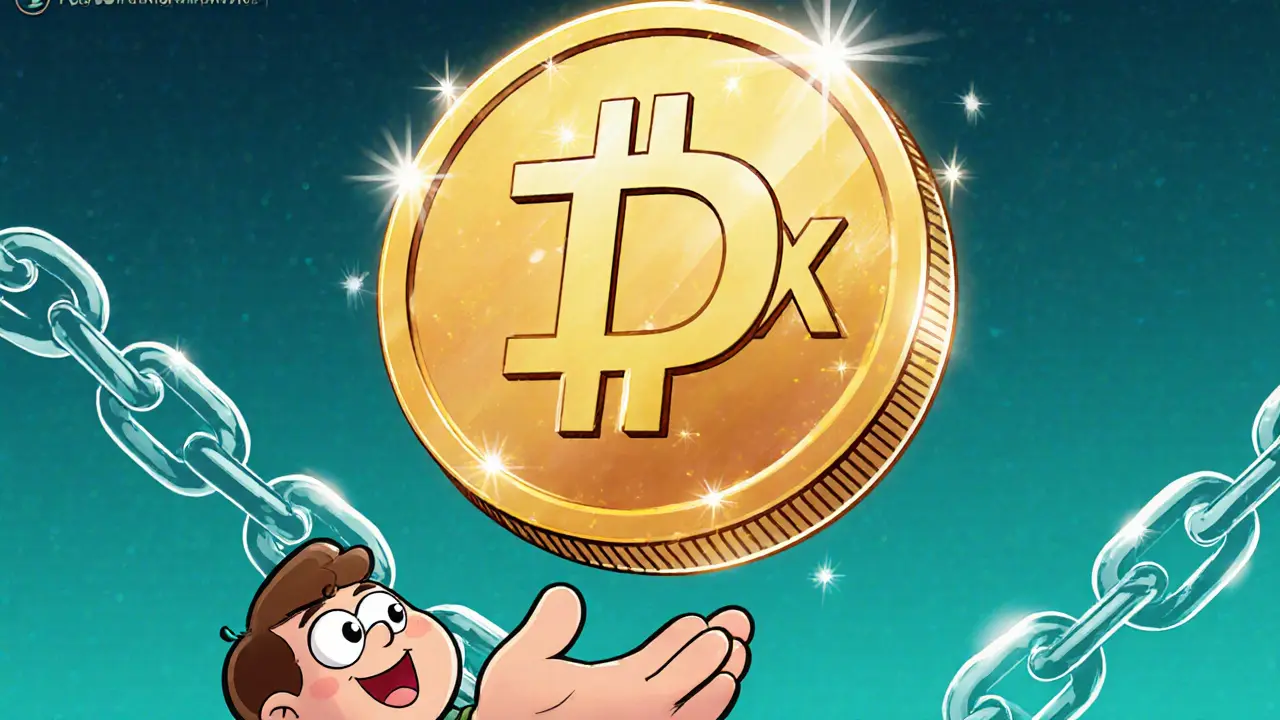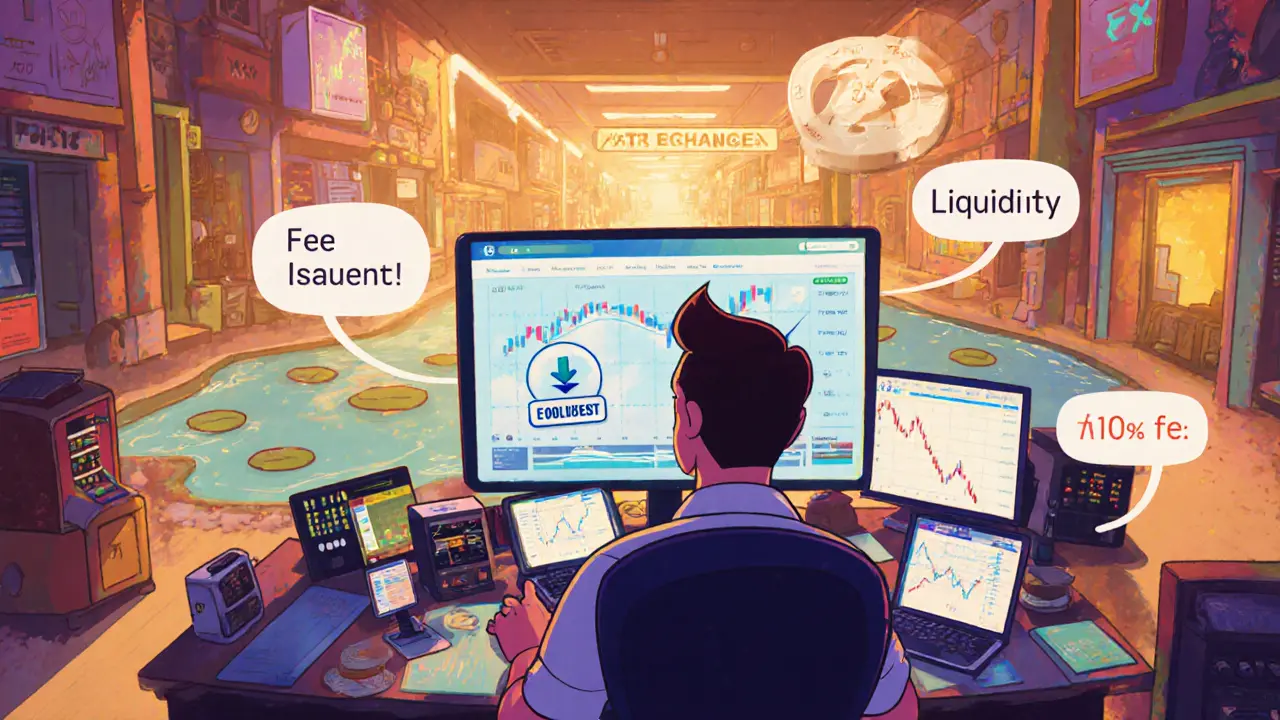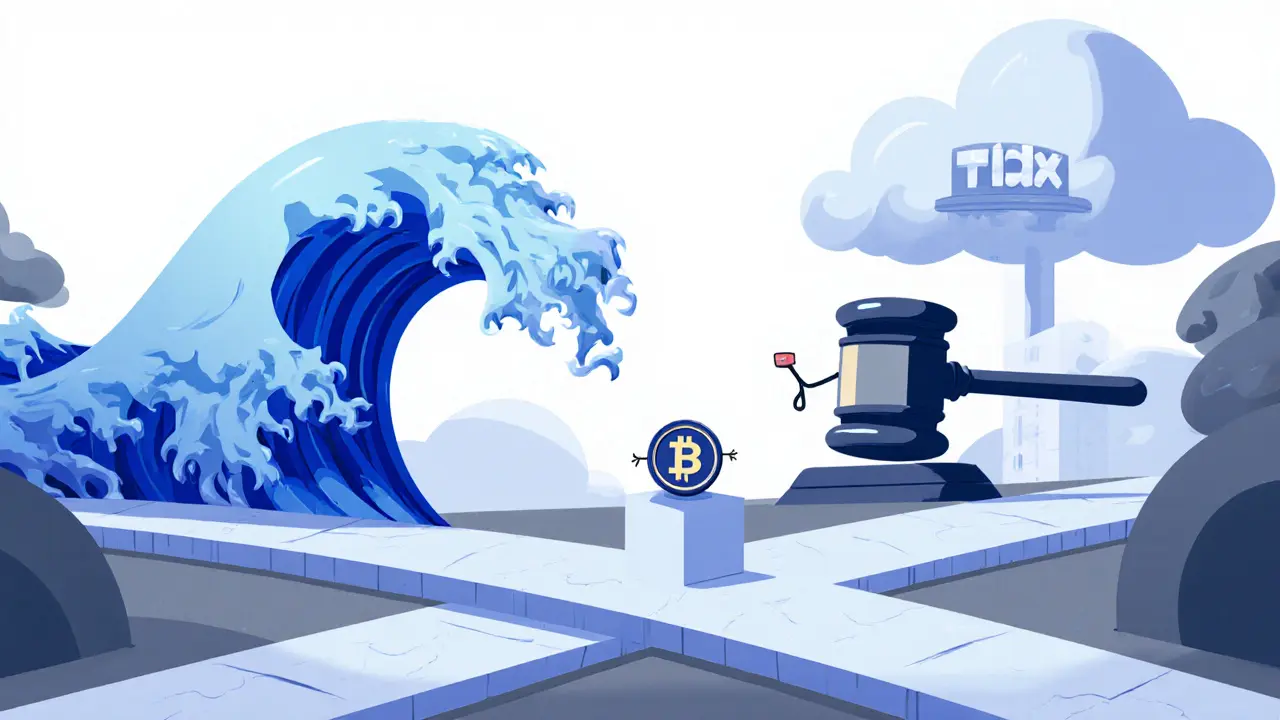 Jan, 27 2025
Jan, 27 2025
TDX Fee Savings Calculator
How TDX Discounts Work
TDX provides fee discounts for trading on the Tidex Exchange. While the exact percentage isn't disclosed, users typically report saving 0.05%-0.15% per trade when paying fees with TDX instead of USDT or BNB.
If you’ve ever skimmed a crypto‑exchange’s fee schedule and saw a mysterious "TDX" listed as a discount option, you’re probably wondering what that actually is. In plain terms, Tidex Token is the native utility coin of the Tidex Exchange platform, created to give traders cheaper fees and some limited access to the exchange’s services.
What is Tidex Token (TDX)?
Tidex Token (TDX) is a service‑based intra‑exchange utility token that lives on the BNB Chain and powers the Tidex Exchange ecosystem. Launched alongside Tidex Exchange in 2017, the token’s sole purpose is to act as a payment medium for maker‑taker fees, NFT marketplace purchases, listing fees for new projects, and occasional community fundraising campaigns.
The token follows the ERC‑20 standard (as implemented on BNB Chain) and can be stored in any wallet that supports BEP‑20 tokens, such as MetaMask, Trust Wallet, or the native Binance Chain Wallet.
Tokenomics at a Glance
Here are the key numbers you’ll see in most analytics dashboards:
- Total supply: 150,000,000 TDX
- Circulating supply (Oct 2023): 18,050,000 TDX - roughly 12% of the total
- Current price (Oct 2023): ≈ $0.0345
- Market cap: about $56,200, ranking #6,451 by market cap on CoinMarketCap
- 24‑hour volume: $0.2062 (on the QMall TDX/USDT pair)
- Fully diluted valuation (FDV): $466,990
Because only a fraction of the tokens are actually in circulation, the market price can swing dramatically on modest buying or selling pressure.
How TDX Provides Value - The Discount Mechanism
Holding TDX lets you pay exchange commissions with the token instead of USDT, BNB or other major coins. The exchange promises “preferential rates” for fee‑payment in TDX, though the exact discount percentages are not publicly disclosed. In practice, users report saving between 0.05% and 0.15% per trade once they have enough TDX to cover the fee.
The discount is the primary utility; there is no staking, governance voting, or lending built into the token’s smart contract.

Where TDX Stands Compared to Bigger Exchange Tokens
| Metric | TDX | BNB (Binance) | FTT (FTX) | KCS (KuCoin) |
|---|---|---|---|---|
| Market cap (USD) | $56,200 | $45 B | $2.1 B | $1.1 B |
| 24h Volume (USD) | $0.2062 | $15 B | $1.3 B | $840 M |
| Listing exchanges | 3 | 100+ | ≈ 70 | ≈ 60 |
| Utility beyond fees | No | Staking, DeFi, governance | Staking, governance | Staking, borrowing |
| Current price (USD) | $0.0345 | $225 | $12.3 | $10.4 |
TDX’s numbers illustrate why it’s classified as a niche token. Its discount‑only utility can be attractive for a trader who already uses Tidex, but the token offers none of the broader ecosystem benefits that make BNB, FTT or KCS popular investment choices.
Pros and Cons - A Quick Checklist
- Pros
- Very low entry price - you can buy a few hundred TDX for under $10.
- Direct fee discount on the native exchange.
- Simple ERC‑20 contract, compatible with most wallets.
- Cons
- Extremely low liquidity - slippage often exceeds 15% on small orders.
- Only listed on three exchanges, making acquisition cumbersome.
- No staking, governance, or cross‑platform use.
- Community engagement is minimal; Telegram/Discord are practically empty.
- Regulatory risk - a utility token confined to one platform could be re‑classified as a security under MiCA.
How to Acquire and Use TDX
Because of the liquidity crunch, the usual route is:
- Create an account on Tidex Exchange (or the secondary market QMall).
- Deposit a stablecoin such as USDT.
- Navigate to the TDX/USDT trading pair. Expect wide bid‑ask spreads; place a limit order slightly below the current market price to reduce slippage.
- Once the order fills, go to the exchange’s fee settings and select “Pay fees with TDX”. The system will automatically deduct the appropriate amount from your TDX balance.
If you prefer to keep the token in a personal wallet, simply add the BNB Chain contract address 0x317eb4ad9cfac6232f0046831322e895507bcbeb to MetaMask and transfer from the exchange after purchase.

Risk Factors You Shouldn't Ignore
Every crypto token carries risk, but TDX stacks several red flags together:
- Liquidity risk: With daily volume under $1, the token can become effectively untradeable. That means you might be stuck holding a token you can’t sell without taking a huge loss.
- Adoption risk: The token’s utility is limited to one exchange. If Tidex ever shuts down or changes its fee model, TDX could become worthless.
- Regulatory risk: EU’s MiCA framework treats single‑platform utility tokens as potential securities, which could trigger delisting or legal action.
- Price volatility: Since March 2018 the token has fallen more than 95% from its all‑time high of $0.8042.
- Information asymmetry: Discount percentages aren’t publicly disclosed, so the real economic benefit is hard to quantify.
Future Outlook - Will TDX Ever Gain Traction?
Most analysts are skeptical. A 2023 CryptoCompare report highlighted that “smaller exchange tokens struggle to attract liquidity when competing against network‑effect giants”. The token’s current roadmap is essentially silent - the last platform update in September 2023 didn’t touch TDX functionality at all.
There is a faint glimmer of hope tied to the Waves Platform. Alexander Ivanov, the founder of both Tidex and Waves, hinted at a possible integration with Waves 2.0 in an August 2023 community call. If that integration materializes, TDX might gain a secondary use case beyond fee discounts. Even then, most projections (AltRank’s optimistic scenario) suggest a maximum 3.2× price increase over two years - modest compared to the 15‑20× gains seen in BNB or KCS.
Bottom line: unless you already trade on Tidex and need the fee discount, treating TDX as a speculative investment is risky.
Bottom‑Line Summary
Tidex Token (TDX) is a low‑price utility coin that only works inside the Tidex Exchange ecosystem. It offers modest fee discounts but suffers from near‑zero liquidity, limited exchange listings, and a lack of broader utility. The token’s market cap sits under $60 k, and daily trading volume is a few cents. For everyday traders who already use Tidex, it might shave a fraction of a percent off fees; for everyone else, the token is more of a curiosity than a viable asset.
What is the main purpose of TDX?
TDX exists to let users pay maker‑taker fees on the Tidex Exchange at a discounted rate. It does not offer staking, voting, or cross‑platform functions.
How can I buy Tidex Token?
The token is available on three exchanges - primarily QMall. Deposit a stablecoin like USDT, place a limit order on the TDX/USDT pair, then transfer the tokens to a BEP‑20 compatible wallet (e.g., MetaMask) or keep them on Tidex for fee discounts.
Is TDX a good investment?
For most investors, the answer is no. The token’s liquidity is extremely low, its market cap is tiny, and it provides value only inside one exchange. If you need the fee discount on Tidex, a small purchase makes sense; otherwise, consider more established exchange tokens.
What are the biggest risks of holding TDX?
Liquidity risk (hard to sell), adoption risk (tied to a single platform), regulatory risk (possible securities classification), and price volatility (down >95% from its 2018 peak).
Will TDX get more utility in the future?
There are hints of integration with the Waves Platform, but no concrete roadmap. Even if it happens, the upside is expected to be modest compared with major exchange tokens.
Scott McCalman
January 27, 2025 AT 03:59Alright folks, let’s cut the nonsense about TDX being the next Bitcoin – it’s just a cheap fee‑discount token on Tidex. The utility is literally “pay fees with TDX” and that’s it, no staking, no governance, nothing to write home about :) . People hype it like it’s a moonshot, but the reality is a few tenths of a cent per token and ultra thin liquidity 😂 . So if you’re trading on Tidex, grab a handful for the discount; otherwise, move on.
PRIYA KUMARI
February 6, 2025 AT 21:35Tidex Token is a pathetic excuse for a “utility” token, and anyone who thinks otherwise is willfully blind. The liquidity is nonexistent, the volume is laughably low, and the discount mechanism is hidden behind vague percentages. It’s a classic pump‑and‑dump playground, and the community is dead‑weight. Stop wasting brain cells on this junk.
Jessica Pence
February 17, 2025 AT 15:11Here’s a quick guide if you actually want to buy TDX: First, sign up on the Tidex exchange or QMall, then deposit USDT. Look for the TDX/USDT pair and place a limit order below the market price – this helps avoid the huge slippage. Once you have some TDX, you can enable “pay fees with TDX” in the fee settings. Remember, you can also store it in any BEP‑20 wallet like MetaMask. Definately double‑check the contract address before transferring.
johnny garcia
February 28, 2025 AT 08:47When evaluating a token such as Tidex's TDX, one must first interrogate the ontological foundation upon which its purported utility rests. The token’s sole raison d’être is to serve as a medium of fee payment within a singular exchange, a function that, in isolation, confers minimal intrinsic value. From a metaphysical perspective, value emerges not merely from utility but from network effects, governance participation, and the capacity for composability across ecosystems. TDX, by contrast, remains an atomistic entity, tethered to a solitary platform, thereby lacking the relational depth that endows other exchange tokens with resilience. Economically, the token’s market cap hovers near $60 k, a figure dwarfed by its peers, which signals a paucity of market confidence. Liquidity metrics further corroborate this, with daily volumes measured in mere cents, rendering price discovery practically impossible. The discount mechanism, while ostensibly beneficial, offers marginal fee reductions-on the order of hundredths of a percent-that are often eclipsed by transaction costs incurred due to slippage. Moreover, the opacity surrounding the exact discount rates undermines rational decision‑making, as investors cannot accurately quantify the return on investment. Regulatory foresight also casts a shadow, as the EU's MiCA framework may reclassify single‑platform utility tokens as securities, jeopardizing their operability. Philosophically, one might argue that a token whose value is contingent upon the continued existence of a single exchange embodies a fragile epistemic construct. Should Tidex alter its fee structure or cease operations, TDX would be bereft of purpose, a terminal case of functional obsolescence. Historically, similar tokens have succumbed to irrelevance once their host platforms evolved or dissolved. Thus, an investor must weigh the speculative allure against the structural vulnerabilities intrinsic to TDX. Consequently, the prudent course for most participants is to regard TDX as a niche tool rather than a growth asset. In summation, while the token provides a modest fee discount for existing Tidex users, its broader investment thesis is tenuous at best. 🌐💭📈
Andrew Smith
March 11, 2025 AT 02:23Great points, everyone! If you’re already on Tidex, grabbing a few TDX can shave off a tiny fee fraction and that’s a win‑win. Let’s keep the discussion friendly and help newcomers navigate the low‑liquidity waters together. Looking forward to more insights from the community.
Ryan Comers
March 21, 2025 AT 19:59This token is a total scam, period! 😠
Prerna Sahrawat
April 1, 2025 AT 14:35One must not be deceived by the ostentatious veneer that TDX attempts to project; beneath the glossy marketing veneer lies a paucity of substantive utility. The token's existence is inextricably bound to the fortunes of a solitary exchange, a circumstance that begets a precarious dependency. While advocates extol the modest fee discount, they conveniently omit the glaring deficiencies: abysmal liquidity, anemic trading volume, and an opaque discount schema that eludes quantitative scrutiny. Such omissions betray a collective myopia, wherein the allure of novelty eclipses sober risk assessment. In the grand tapestry of the cryptocurrency ecosystem, TDX resembles a peripheral ornament rather than a cornerstone. Consequently, discerning investors would be well advised to allocate capital toward assets endowed with robust network effects and diversified applicability. Nonetheless, for the die‑hard Tidex loyalist, the token may retain a modicum of sentimental value, albeit at the expense of rational portfolio construction.
Joy Garcia
April 12, 2025 AT 08:11It’s eerily suspicious how regulators have kept their eyes on niche tokens like TDX, as if waiting for the perfect moment to swoop in and declare them securities. The lack of transparency around discount rates feels like a deliberate obfuscation, perhaps a prelude to a crackdown that will leave holders stranded. One can’t help but wonder whether the token’s creators are colluding with shadowy entities to keep the community in the dark.
mike ballard
April 23, 2025 AT 01:47From a cultural lens, TDX embodies the classic “exchange‑centric utility” archetype, leveraging fee‑reduction as its core value proposition. The token integrates seamlessly within the Tidex ecosystem, yet its cross‑platform interoperability remains non‑existent, limiting its broader adoption potential. Traders often grapple with the thin order book, which amplifies slippage and undermines execution quality. To mitigate these friction points, users typically employ limit orders and monitor the spread closely. :)
Molly van der Schee
May 3, 2025 AT 19:23I hear the concerns about liquidity and regulatory risk, and they’re absolutely valid. It’s tough to feel confident when the market depth is shallow and the future of the token feels uncertain. At the same time, for those who already trade on Tidex, the modest discount can be a small but helpful perk. Let’s keep supporting each other as we navigate these tricky waters.
Mike Cristobal
May 14, 2025 AT 12:59It’s morally questionable to hype a token that offers almost no real benefit beyond a negligible fee discount, especially when the community is left in the dark about the exact savings. Promoting such an asset without full disclosure borders on deceptive practice. Investors deserve honesty, not glossy promises. 🙏
Erik Shear
May 25, 2025 AT 06:35We should all stay calm this is just a tiny token with limited use no need for hype
Tom Glynn
June 5, 2025 AT 00:11Remember, the journey of investing is as much about learning as it is about profit. TDX may teach you valuable lessons about liquidity, utility, and risk, even if it doesn’t become a blockbuster. Keep a level head, stay curious, and use each experience as a stepping stone toward wiser decisions. 🚀
Johanna Hegewald
June 15, 2025 AT 17:47In short, TDX only helps if you trade on Tidex a lot. Otherwise, look for other exchange tokens that have more features.
Benjamin Debrick
June 26, 2025 AT 11:23Indeed, the discourse surrounding TDX necessitates a meticulous examination, for, as is evident, the token’s singular utility-namely, the payment of exchange fees-renders it a marginal instrument within the broader cryptographic milieu; consequently, one must consider the paucity of liquidity, the opacity of discount mechanisms, and the potential for regulatory reclassification, all of which coalesce to diminish any substantive investment thesis, thereby relegating TDX to the periphery of strategic asset allocation.
Anna Kammerer
July 7, 2025 AT 04:59Oh sure, because what the world really needed was another token that only works on one exchange-how original! Jokes aside, if you’re already on Tidex the tiny discount might be worth the hassle, but for anyone else it’s just another dust collector.